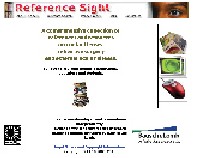Digital Fundus Camera
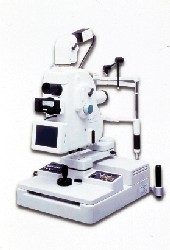 |
The Nonmyd a-D Non-mydriatic Fundus Camera, from Kowa, is a compact, all-in-one unit ideally suited for notebook computers and the companys VK-2 Digital Imaging System. The camera offers high-resolution digital imaging with its built-in 2.1-megapixel digital camera (Kowas KD-211C). Other features include:
A user-friendly interface.
Easy-to-reach controls for rapid screening.
Two picture angles (45 degrees and 20 degrees).
A 5.6-inch color LCD monitor for inspection of patient images.
A USB attachment that allows the camera to communicate with virtually any office or network PC with plug-and-play ease, the company says.
Call 1-800-966-5892, or go to www.kowa.com.
Digital Acuity Chart System
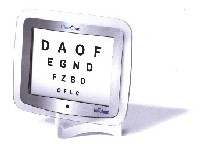 |
The ClearChart Digital Acuity System, from Reichert Ophthalmic Instruments, is a 15-inch LCD flat panel screen that digitally displays crowding bars, HOTV letters, the ETDRS chart, Landolt rings, the Snellen chart, Tumbling E and the red/green test. The device reduces patient memorization and can be used with room lights on, the company says.
An infrared remote control activates the desired test and lets you change the optotype lines, size and display. Additional features include random sequencing, contrast-sensitivity testing and a patient communication system for the hearing-impaired. Call (716) 686-4500, or go to www.reichertoi.com.
Non-Contact Diagnostic Lens
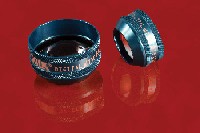 |
The Digital Wide Field non-contact lens, from Volk Optical, allows the magnification of small pupils similar to the magnification provided by the Volk 90D lens, but with enhanced resolution, a much wider field of view and reduced glare and reflections, the company says.
Features include:
A 103/124 degree (static/dynamic) field of view.
Visualization similar to a contact lens, according to Volk Optical.
A detailed view of the macula and disc via 0.72x magnification.
High-index glass construction for a high-resolution image, even under increased slit lamp magnification, the company says.
A reduction in the incidence of reflections and glare due to the lens shape and coating.
The companys patented double-aspheric design, which prevents distortion across the entire lens.
A two-in-one design, so you dont have to switch lenses mid-exam.
Call 1-800-345-8655, or go to www.volk.com.
Anatomy Software For Retinal Thickness Analyzer
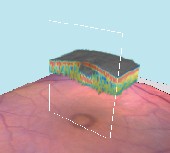 |
The 3D Anatomy Imager software, from Talia Technology, is now part of the companys Retinal Thickness Analyzer (RTA). Using sequential images, the software reconstructs a 3D visualization of the 3mm-by-3mm image acquired by the RTA. The volume, which you control by resectioning, cutting, zooming or measuring, is automatically registered on the fundus image.
You can show the image in black and white or color code it using the softwares algorithms, which enhance the inner structure of the retinal layers. This lets you measure, enlarge and examine, up close, pathologies such as macular holes and cysts.
You can also record a movie clip of the 3D visual, and save the clip in a standard format to e-mail to another doctor, place on a CD or use as a patient education tool. Call 1-800-214-2030, or go to www.talia.com.
New Slit Lamp
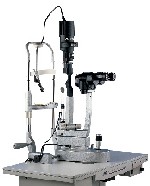 |
The BP-900 slit lamp, from Haag-Streit, has two optional beam splittersone for video and the other for digital photography. Each splitter outlet accepts most commercial digital cameras and all commercial c-mount cameras.
The slit lamp also features a Tungsten bulb that provides up to 600,000 lux illumination. A push button on top of the joystick controls the levels of illumination, while a dial on the side of the device lets you switch between 10x, 16x and 25x magnifications. Call 1-800-787-5426, or go to www.haag-streit-usa.com.
CONTACT LENSES
Progressive Toric Lens
CIBASOFT Progressive Toric, a new toric multifocal lens from CIBA Vision, features a double slab-off, front-surface toric design combined with a center-near progressive add on the back surface.
The lens is made of tefilcon, a non-ionic material that has a 37.5% water content. It comes in a 14.5mm diameter, 8.6mm and 8.9mm base curves, a power range of +9.00D to 9.00D, cylinders of 0.75D to 2.75D (0.25D steps) and around-the-clock axes (5 steps). A zero-cylinder is available for patients who require astigmatic correction in one eye only. CIBA Vision recommends a 6-month to annual replacement schedule. The lens comes in a vial.
A CD-ROM and fitting card are available to assist practitioners. Call 1-800-241-5999, or go to www.cibavision.com.
OPHTHALMIC LENSES
Progressive Polarized Lens
Definity progressive lenses, from Johnson & Johnson Vision Care, are now available in a polarized version. The new polarized lenses feature 1.50 lens material, NuPolar technology from Younger Optics and ultraviolet and glare protection. The lenses are available in sphere powers of +4.00D to 10.00D and up to 4.00D cylinder.
The lens is currently available in gray and will be offered in brown sometime this month. Call 1-800-920-2021 ext. 3700, or go to www.definity.com.
 |
The Varilux Ipseo progressive lens, from Essilor, marries the patients prescription with Variluxs Vision Print System (VPS), a diagnostic device that uses physiological measurements of the wearers head and eye movements to optimize the patients field of vision, the company says.
Varilux Ipseo is available in Essilors Thin & Lite 1.67 material with the AR coating Crizal Aliz. It is available in sphere powers of +6.00D to 10.00D, up to 4.00D cylinder and add powers of +0.75 to +3.50 (0.25 steps).
Another personal touch: The wearers initials are engraved on the lens. For more information about Varilux Ipseo, contact your Essilor brand consultant, or go to www.essilorusa.com.
LAB EQUIPMENT
Segment Height Gauge
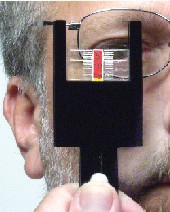 |
The Gulden Seg Gauge, from Gulden Ophthalmics, helps you determine the placement of segment height for multifocal lenses, such as bifocals, progressives, flat tops, trifocals or any other type of add.
The gauge tells you whether there is sufficient depth within the frame to allow for a complete progressive lens according to manufacturer specs. Specifically, the segment height falls into one of three zones:
The green zone, which means the lens will fit.
The yellow zone, which means the patient will have to pay a premium for compact progressives.
The red zone, which means the frame is too small for the progressive.
Call 1-800-659-2250, or go to www.guldenophthalmics.com.
Dispensing Table Imager
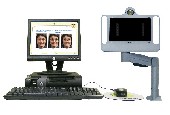 |
The Dispensing Table Imager (DTI), from Eyeweb Inc., uses digital imaging technology to help you and your patients choose ophthalmic lenses or colored contact lenses. The DTI features these four modes:
Measurement Mode, which measures pupillary distance (PD) and fitting height of the frame on the face. The PD measurements are accurate within 0.3mm, the company claims.
Lens Simulator Mode, which lets patients see how they look in polarized, photochromic, solid and gradient lenses.
Virtual Mode, which lets patients see how they look in color contact lenses. This mode also offers a virtual online boutique that allows patients to virtually try on, save (for future access) and reserve frames from their own homes.
Demo Mode, which uses a model rather than a patient image to demonstrate rimless, plastic and metal frames.
Handles on the face of the DTI facilitate movement to and from a patients face, while an adjustable arm and head allow for easier image capture. Additional features include ample lighting to ensure a quality image and a space-saving design (the device is about the size of a phoropter, the company says). Call 1-877-439-3932, or go to http://www.eyeweb.com
OFFICE DESIGN
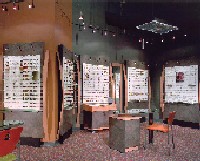 |
| The Flex collection, from Eye Designs, features modular showcases, curved details, elliptical-shaped dispensing tables and low-voltage lighting to create a metropolitan interior, the company says. Call 1-800-346-8890, or go to www.eyedesigns.com. |
|
WHAT"S NEW ON THE WEB
New Ocular Web Site ReferenceSight.com, from the Centre for Contact Lens Research (CCLR) at the University of Waterloo School of Optometry, is an extensive database of resources and references on contact lenses, external ocular disease and refractive surgery. The site, formerly known as Vision Science Reference Database, features more than 2,000 journals and professional texts, more than 100,000 references that are updated monthly, hundreds of clinical photographs, and full abstracts and links to reprint sites, publishers and e-text (where available).
Additional functions allow users to: Submit their own images. |
For the record
In the Product Review section in Februarys Review of Optometry, Luxottica Group should have been named as the manufacturer of Versace frames for women. Review of Optometry regrets any confusion.
